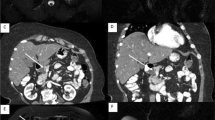Abstract
Background
Resection is recommended for main duct intraductal papillary mucinous neoplasms (IPMNs) of the pancreas because of the high risk of malignancy, but the indications for resection of branch duct and mixed-type IPMNs remain controversial. Our objective was to determine the appropriate management of IPMNs based on clinicopathologic characteristics and survival data obtained after resection.
Methods
A total of 72 consecutive IPMN patients who underwent resection between January 1984 and June 2006 were reviewed. The lesions were classified as main duct, branch duct, or mixed-type IPMNs and histologically graded as noninvasive (adenoma, borderline neoplasm, carcinoma in situ) or invasive.
Results
Main duct IPMNs (n = 15) were associated with a significantly worse prognosis than other subtypes. For branch duct (n = 49) and mixed-type IPMNs (n = 8), the diameter of the cystic lesions was an independent predictor of malignancy by multivariate analysis. However, four patients with cysts <30 mm in diameter and no mural nodules had a malignancy. No patient with noninvasive IPMN died of this disease, showing excellent survival, whereas the 5-year survival rate of patients with invasive IPMNs was only 57.6% and was significantly worse than that of patients with noninvasive IPMNs (p = 0.0002).
Conclusions
Resection of all main duct IPMNs seems to be reasonable. Invasive IPMNs were associated with significantly worse survival than noninvasive IPMNs. Although the diameter of cystic lesions was a predictor of malignancy for branch duct and mixed-type IPMNs, precise preoperative identification of malignancy was difficult. Therefore, these lesions should be managed by aggressive resection before invasion occurs to improve survival.




Similar content being viewed by others
References
Ohashi K, Murakami Y, Maruyama M, et al. (1982) Four cases of “mucin-producing” cancer of the pancreas on specific findings of the papilla of Vater [in Japanese]. Prog Dig Endosc 20:348–351
Kloeppel G, Solcia E, Longnecker DS, et al. (1996) Histological typing of tumours of the exocrine pancreas. in: World Health Organization International Histological Classification of Tumours. 2nd edition. Springer, Berlin
Longnecker DS, Adler G, Hruban RH, et al. (2000) Intraductal papillary mucinous neoplasms of the pancreas. In: Hamilton SR, Aaltonen LA (eds) World Health Organization Classification of Tumours, Pathology and Genetics of Tumors of the Digestive System. IARC Press, Lyon, pp 237–241
Tanaka M, Kiishiro K, Kazuhiro M, et al. (2005) Clinical aspects of intraductal papillary mucinous neoplasm of the pancreas. J Gastroenterol 40:669–675
Tanaka M, Chari S, Adsay V, et al. (2006) International consensus guidelines for management of intraductal papillary mucinous neoplasm and mucinous cystic neoplasm of the pancreas. Pancreatology 6:17–32
Doi R, Fujimoto K, Wada M, et al. (2002) Surgical management of intraductal papillary mucinous tumor of the pancreas. Surgery 132:80–85
Sohn TA, Yeo CJ, Cameron JL, et al. (2004) Intraductal papillary mucinous neoplasms of the pancreas: an updated experience. Ann Surg 239:788–799
Wada K, Kozarek RA, Traverso LW (2005) Outcomes following resection of invasive and noninvasive intraductal papillary mucinous neoplasms of the pancreas. Am J Surg 189:632–637
Matsumoto T, Aramaki M, Yada K, et al. (2003) Optimal management of the branch duct type intraductal papillary mucinous neoplasms of the pancreas. J Clin Gastroenterol 36:261–265
Sugiyama M, Izumisato Y, Abe N, et al. (2003) Predictive factors for malignancy in intraductal papillary mucinous tumours of the pancreas. Br J Surg 90:1244–1249
Salvia R, Fernández-del Castillo C, Bassi C, et al. (2004) Main-duct intraductal papillary mucinous neoplasms of the pancreas: clinical predictors of malignancy and long-term survival following resection. Ann Surg 239:678–687
Yamaguchi K, Ogawa Y, Chijiiwa K, et al. (1996) Mucin hypersecreting tumors of the pancreas: assessing the grade of malignancy preoperatively. Am J Surg 171:427–431
Traverso LW, Peralta EA, Ryan JA Jr, et al. (1998) Intraductal neoplasms of the pancreas. Am J Surg 175:426–432
Sugiyama M, Atomi Y (1998) Intraductal papillary mucinous tumors of the pancreas: imaging studies and treatment strategies. Ann Surg 228:685–691
Shima Y, Mori M, Takakura N, et al. (2000) Diagnosis and management of cystic pancreatic tumours with mucin production. Br J Surg 87:1041–1047
Sobin LH, Wittekind Ch (2002) International Union Against Cancer (UICC): TNM Classification of Malignant Tumours. 6th edition. Wiley-Liss, New York
Inokuma T, Tamaki N, Torizuka T, et al. (1995) Eevaluation of pancreatic tumors with positron emission tomography and 18F-fluorodeoxyglucose: comparison with CT and US. Radiology 195:345–352
Suzuki Y, Atomi Y, Sugiyama M, et al. (2004) Cystic neoplasms of the pancreas: a Japanese multiinstitutional study of intraductal papillary mucinous tumor and mucinous cystic tumor. Pancreas 28:241–246
Yamao K, Ohashi K, Nakamura T, et al. (2001) Evaluation of various imaging methods in the differential diagnosis of intraductal papillary mucinous tumor (IPMT) of the pancreas. Hepatogastroenterology 48:962–966
Sosa JA, Bowman HM, Gordon TA, et al. (1998) Importance of hospital volume in the overall management of pancreatic cancer. Ann Surg 228:429–438
Gouma DJ, van Geenen RC, van Gulik TM, et al. (2000) Rates of complications and death after pancreaticoduodenectomy: risk factors and the impact of hospital volume. Ann Surg 232:786–795
Acknowledgments
This work was supported by Grants-in-Aid (17390364, 17659409) from the Ministry of Education, Culture, Sports, Science, and Technology of Japan.
Author information
Authors and Affiliations
Corresponding author
Rights and permissions
About this article
Cite this article
Nagai, K., Doi, R., Kida, A. et al. Intraductal Papillary Mucinous Neoplasms of the Pancreas: Clinicopathologic Characteristics and Long-Term Follow-Up After Resection. World J Surg 32, 271–278 (2008). https://doi.org/10.1007/s00268-007-9281-2
Published:
Issue Date:
DOI: https://doi.org/10.1007/s00268-007-9281-2




